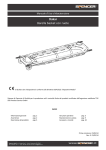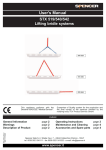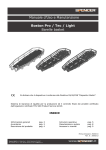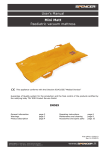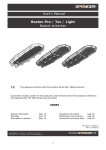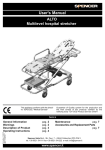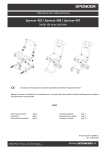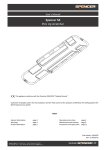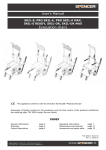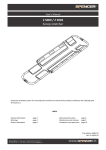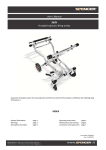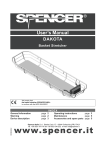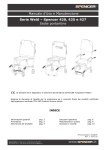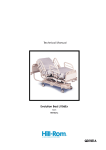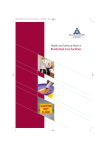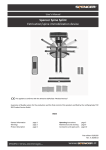Download Dakar Basket stretcher with wheels
Transcript
User’s Manual Dakar Basket stretcher with wheels This appliance conforms with the Directive 93/42/CEE “Medical Devices” Guarantee of Quality system for the production and the final control of the products certified by the notifying body TÜV SÜD Product Service GmbH INDEX General information Warnings Product description page 2 page 2 page 5 Operating instructions Maintenance and cleaning Accessories and spare parts page 6 page 9 page 10 First edition: 21/03/14 Rev. 0: 21/03/14 1 Thank you for choosing a Spencer product 1. GENERAL INFORMATION 1.1 Aim and contents The aim of this manual is to supply all the information necessary so that the client, will not only attain adequate use of the appliance, he will also be capable of using the instrument in the most autonomous and secure way possible. This includes information regarding technical aspects, functioning, maintenance, spare parts and safety. 1.2 Conservation of the instruction and maintenance manual The instruction and maintenance manual must be kept together with the product, for the whole life of the device, inside a dedicated container and above all, away from any substances or liquids which could compromise perfect legibility. 1.3 Symbols used Symbol Meaning General or specific warnings See instructions for use Lot number Product code The product is compliant with the specifications of the Directive 93/42/CEE 1.4 Servicing request For any information regarding the correct interpretation of the instruction manual, the use, maintenance, installation and restore of the product, please contact the Spencer Customer Care Service tel. 0039 0521 541111, fax 0039 0521 541222, email [email protected] or write to Spencer Italia S.r.l. - Strada Cavi, 7 - 43044 Collecchio (Parma) - ITALY. In order to facilitate the assistance service, please always indicate the serial number (SN) or lot number (LOT) shown on the label applied on the box or on the device. 1.5 Demolition When the devices are no more suitable for being used, if they haven’t been contaminated by any particular agents, they can be disposed of as normal solid waste, otherwise follow the current regulations about demolition. The disposal of the accessories and the medical device shall be performed according to the current regulations in each country. 1.6 Labelling Each device has got an identifying label, positioned on the device itself and/or on the box. This label includes information about the manufacturer, the product, the CE mark, the serial number (SN) or lot number (LOT). It must never be removed or covered. 2. WARNINGS 2.1 General warnings • The product must be used by trained personnel only, having attended specific training for this device and not for similar products. • Training routines must be registered on a special register in which the names of those trained, of the trainers, date and place are indicated. This register which will certify the eligibility of the operators to use the Spencer device has to be kept for a period of 10 years after the disposal of the device itself. This register will be made available to the competent authorities and/or manufacturer if requested. • Spencer Italia S.r.l. is always at your disposal to plan trainings on products. • Before carrying out any kind of operation on the appliance (training, installation, use), the operator must carefully read the enclosed instructions, paying particular attention to the correct safety precautions and to the procedures to be followed for installation and for correct use. • If the instructions belong to another device and not to the device received, inform the manufacturer immediately and avoid use of the device. • In case of any doubts about the correct interpretation of the instructions, please contact Spencer Italia S.r.l. for any necessary clarifications. • Do not allow untrained persons to help during the use of the device, because they could cause damage to the patient or to themselves. • Regularly check the appliance, carry out the prescribed maintenance and respect the average life span, as indicated by the manufacturer in this user’s manual. 2 • Before each use of device the perfect operating state of the device must be checked as specified in the instruction manual. If any damage or abnormalities which could in any way influence the correct functioning and the safety of the device, of the patient and of the user are detected, the device must be immediately removed from service and the manufacturer must be contacted. • If any failure or incorrect functioning of the device is detected, it must be immediately substituted with a similar item so that the rescue procedures are guaranteed without any interruption. • Use of the device in anyway other than described in this manual is forbidden. • Do not alter or modify in any way the appliance; any such interference could cause malfunctions and injury to the patient and/or rescuer. • The appliance must not in any way be tampered with (modification, adjustment, addition, replacement). In such cases all responsibility will be denied for any malfunctions or injuries caused by the appliance itself; moreover CE certification and product warranty will be considered void. • Those who modify or have modified, prepare or have prepared medical appliances in such a way that they no longer serve the purpose for which they were intended, or no longer supply the intended service, must satisfy the valid conditions for the introduction onto the market. • Handle with care. • Ensure that all the necessary precautions are taken in order to avoid the hazards that can arise as the result of contact with blood or body fluids. • Register and store with these instructions: lot number, place and date of purchase, first date of use, date of checks, name of users, any comments. • When the device is being used, the assistance of qualified staff must be guaranteed. • Do not store the device underneath any heavy objects which could cause structural damage. • Store in a cool, dry, dark place and do not expose to direct sun. • Store and transport device in its original packaging. • The device not be exposed to or come into contact with any source of combustion or inflammable agents. • Position and adjust the device taking care not to cause any obstruction to rescuers and or any other rescue equipment. • Attention: laboratory testing, post production tests, instruction manuals cannot always consider every possible scenario for use. This means that in some cases the performance of the product could be notable different from results to date obtained. Instructions are continually being updated and are under tight surveillance of fully qualified staffs with adequate technical formation. • With reference to the D. Lgs. 24th February 1997, n. 46 emended by D. Lgs. 25/01/2010, n. 37 – Acknowledgement of Directive 93/42/CEE and 2007/47/CE, we remind both public and private operators that they are obliged to report any accident that involves any medical device to the Ministry of Health and to the Manufacture as specified and within time given by the European regulations. • In addition, both public and private operators are obliged to inform the manufacturer of any measures that should be adopted to make the steps necessary to guarantee the safety and the health of the patients and the users o any medical device. • As a distributor or end user of products manufactured and/or marketed by Spencer Italia S.r.l., you are strictly required to have a basic knowledge of any legal requirements applying to the devices contained in this supply that are in power in the goods final destination Country (including laws and norms regarding technical specifications and/or safety requirements) and therefore you are also strictly required to have the necessary knowledge to guarantee all aspects regarding the total conformity of the products to the regulations in the relevant territory. • Promptly notify Spencer Italia S.r.l. regarding any revisions to be made by manufacturer in order to guarantee the conformity of the product to the territory’s legal specifications (including those resulting from rules and/or norms of other nature). • Act, with all due care and diligence, and contribute to ensure conformity to general safety requirements of all devices marketed in the territory, by providing final users with all necessary information for carrying out periodical checks on their devices, as specified in the relevant user’s manual. • Actively contribute to product safety checks on products sold, by communicating any relevant risk analysis information both to the manufacturer and to any competent authorities so that the necessary action can be promptly taken. • The distributor or final user is aware that in the event of any failure to conform to the above mentioned requirements you will be deemed fully responsible for all damages that might occur. Therefore Spencer Italia S.r.l. expressly disclaims any responsibility and/or liability for your non-compliance with the present regulatory provisions. 2.2 Specific warnings • Establish a maintenance program and periodic testing, identifying a reference employee. The person to whom the ordinary maintenance of the device is entrusted must ensure the basic requirements foreseen by the manufacturer in the user’s manual. • All maintenance and periodic check activities must be registered and collected together with their intervention reports (see Maintenance Register) these documents have to be kept for a period of 10 years after the disposal of the device itself. This register will be made available to the competent authorities and/or manufacturer if requested. 3 • Use only components/spare parts and/or accessories that are original or approved by Spencer Italia S.r.l. in order to carry out any operation without causing any alteration or modification to the device, otherwise we assume no responsibility for the proper functioning or damage resulting from device to the patient or the operator and warranty and will be considered void according to the compliance to the Medical Device Directive 93/42/CEE. • Always respect the maximum load capacity of the device, as indicated in this user's manual. Maximum load capacity means the total weight distributed according to the human anatomy. In determining the load of the total weight on the product, the operator must consider the weight of the patient, the equipment and the accessories. Moreover, the operator must consider that the overall dimensions of the patient do not reduce the functionality of the device. • Never leave the patient unassisted on the device, because he may be injured. • The device and all its components, after washing, should be allowed to dry completely before storing. • Lubrication must be carried out after cleaning and complete drying. • Follow the procedures approved by the Emergency Medical Service for the immobilization and transport of patients. • Follow the procedures approved by the Emergency Medical Service for the positioning and transport of patients. • Avoid contact with sharp objects. • Make sure, before lifting, that the operators have a firm grip on the device. • Avoid pulling the device on rough surfaces. • The device is a stretcher for the transport of patients and can not be used as a parking device. • Have practice with an empty stretcher, in order to make sure you become familiar with the manoeuvres. • The use of the device requires at least two operators in suitable physical conditions, they must therefore be endowed with strength, balance, coordination, and common sense and they must be trained on the proper operation of the device Spencer stretcher. • For loading techniques of the patient, for particularly heavy patients, for working on uneven ground or in special and unusual circumstances, the presence of more operators is recommended (not only 2 as expected under standard conditions). • The maximum weight supported by each rescuer must comply with the requirements prescribed by the law of the land, in the field of Health and Safety at Work. • Before each use, check the integrity of the belts and their hooks, as specified in the user’s manual. In case of malfunction or damage that may compromise the functioning and safety of the device, patient or operator, it is necessary to replace the belts. • Make sure the belts are properly fastened to the frame/patient board of the stretcher. • Always immobilize the patient, using the straps supplied by the Manufacturer; lack of immobilization may cause serious damage. • Do not operate in case the weight has not been distributed correctly. • Use the stretcher only as described in this user's manual. • Do not alter or modify the stretcher arbitrarily to make it fit into the ambulance: the modification may cause unforeseeable functioning and damage to the patient and operators. In any case the warranty will be void. • Pay a lot of attention to possible obstacles (water, ice, debris, etc.) on the route of the stretcher, because they could cause loss of balance of the operator and compromise the proper functioning of the device. If the path free cannot be made free of obstacles, choose an alternative path. • During the hoisting stages the stretcher must be kept horizontal to the ground, any abnormal inclinations can cause serious harm to the patient, the device and the operator. • For hoisting use only the appropriate hooks sling attachment points as shown on the instructions. • The stretcher can be hoisted only with Spencer lifting bridles. • Dragging the basket stretcher on surfaces of all types leads into premature deterioration which reduces the life span and the initial safety conditions. • The Dakar basket stretcher can not be used in water, since the mechanisms present are not compatible and may be damaged. 2.3 Contraindications and side effects The use of this device, if used as described in this manual, does not present any contraindications or collateral effects. ZIONE DEL PR 2.4 Physical requirements of the operators Spencer Dakar is a device destined to professional use only. The rescue operators must have the following minimum requirements: • physical capacity for operating the device • be able to seize the device firmly with both hands • have strong back, arms and legs for lifting, pushing and pulling the stretcher • have a good muscular coordination The operators must be trained in efficient, effective and safe patient transport. 4 Patient loading procedures for extremely heavy patients, operations in rough terrain and in particular situations more operators may be needed (not only two as in normal conditions). The capacities of the various operators must be considered before determining their role in the employment of the stretcher. 3. DESCRIPTION OF PRODUCT 3.1 Intended use Spencer Dakar basket stretchers are devices designed for the rescue and transport of patients. They can be used in all rescue operations in which it is impossible to intervene with the standard transport methods and where the patient needs protection from possible side impact. Spencer Dakar can be hoisted, maintaining in all cases the stretcher in horizontal position to the ground, only if equipped with a Spencer lifting system. These devices are not designed for any intervention on behalf of the patient. 3.2 n° 1 2 3 4 5 6 7 8 9 Main components Description Wheels ø 200 mm Locking push-button of extractable handles Reinforced rings for hoisting Additional handles formed in the main body Mattress Rope Handgrip of extractable handles Footrest Fastening belts Material Polypropylene/Polyethylene Nylon Alumium Polyethylene Polyethylene Polypropylene Rubber Polyethylene Polypropylene Fig. A Fig. B 3.3 Models These basic models could be modified, with reference to codes and/or descriptions without any previous notification. ST04070B Dakar basket stretcher with wheels, orange ST04071B Dakar basket stretcher with wheels, yellow 3.4 Technical data Characteristics Height (mm) Width (mm) Length with closed handles (mm) Length with extended handles (mm) Weight (kg) Load capacity (kg) 190 640 2240 2760 16±0.5 356 5 3.5 Reference standards Reference MDD 93/42/CEE MDD 2007/47/CEE Legislative Decree 24/02/1997, n. 46 Legislative Decree 25/01/2010, n. 35 UNI EN ISO 14971 UNI CEI EN ISO 15223-1 UNI CEI EN 1041 CEI EN 62366 MEDDEV 2.4/1a-b NB-MED 2.5.1/Rec 5 MEDDEV 2.7.1 MEDDEV 2.12/1 UNI EN 14155 Title of document European Directive about Medical Devices Modifications to 90/385/CEE Directive about active implants, Directive 93/42/CEE about medical devices and Directive 98/8/CE about the introduction of biocides onto the market Application of the 93/42/CEE Directive about Medical Devices Modifications and additions to the 20/02/97 Decree n. 46 Application of risks managing to medical devices Medical devices - Symbols for use in the medical device labels, labelling and information to be provided. Part 1: general requirements Information supplied by the medical devices manufacturer Medical Devices - Application of the utilisation characteristics of engineering to medical devices Guideline for the classification of medical devices Technical Documentation Clinical Data Medical Devices vigilance system Clinical evaluation of the medical devices for human beings - Part 2: Clinical evaluation plans 3.6 Environmental conditions Functioning temperature: from -10 to +45 °C Storage temperature: from -20 to +60 °C 4. OPERATING INSTRUCTIONS 4.1 Transport and storage Before transporting the appliance, make sure that it is correctly packaged ensuring also that there are no risks of shocks, bumps or falls during the transport itself. Keep the original packaging for use in case of any further transport and for storage. Damage to the appliance caused during transport and handling is not covered by the guarantee. Repairs or replacement of the damaged parts are the responsibility of the client. The device must be stored in a dry, cool area away from direct sunlight. It must not be placed in contact with any substances or chemical agents which could cause damage and reduce safety characteristics. 4.2 Preparation On receipt of the product: • Remove the packaging and display the material so that all components are visible. • Check that all the components/pieces on the accompanying list are present. The appliance must be checked before every use so as to reveal any working abnormalities and/or damage caused by transport and/or storage. In particular, check: • General functionality of the device • Cleanliness of the device (remember that the failure of cleaning may cause the risk of cross infections) • Absence of cuts, holes, tears on the structure, including the straps • Correct fixation of all nuts, bolts and screws • Correct fixation of straps • Correct fastening of straps • State of use (moving parts, belts) • Integrity of components • Lubrication of moving parts • There are safety belts for the immobilization of the patient and they are intact and functioning • No piping or metal sheet present bends or cracks • The restraining rope is sufficiently tight. • Presence of the footrest. • Functioning of the couplings (closing them and opening them in succession) • Cleaning of the couplings and the absence of external parts to the mechanisms If the above conditions are met, the device may be considered ready for use; otherwise you must immediately remove the device from service and contact the Manufacturer. 6 4.3 Functioning 4.3.1 Putting the patient in the stretcher Before moving, lifting or transporting the patient, the primary medical decisions must be made. • Before moving, lifting or transporting the patient, the primary medical decisions must be made; after the diagnosis, it is best (if possible) to suggest co-operation of the patient in transferring him/her to the stretcher, by informing the casualty of the risks involved. • Depending on the patient's condition, the environmental conditions and the rescue situation, the basket stretcher can be covered with one or more blankets to provide extra warmth and protection to the patient. • Spencer Dakar basket stretchers are compatible with immobilization systems such as head immobilizer or spine boards. • In case of prior immobilization on spine board, refer to the user’s manual of this device. • Place the stretcher as close as possible to the patient before transfer. • Load the traumatised patient following the specifications approved by the EMS service. • Secure the patient to the stretcher with the apposite restraint belts provided with the device or others approved by Spencer Italia S.r.l., check that the belts are firmly fixed to the structure of the basket stretcher, make a correct tensioning of the belt according to the patient's condition. • Position the footrest at the proper height so that the flat surface is in contact with the patient's feet in order to avoid longitudinal displacements. • Insert the hooks on the ends of the belt into the slots/handles on the perimeter of the Spencer Dakar (fig. C and D). • Make sure the footrest is correctly centered on the belts and it maintains a position perpendicular to the surface of the stretcher. If the patient has got leg injuries, immobilize the legs with specific equipment required by procedures approved by the Emergency Medical Service for the immobilization and transportof the patient. Fix the patient to the Dakar with a great number of belts according to instructions by the chief rescuer (it is suggested to use an extra pair of belts crossed in the area of the shoulders and torso). Fig. D Fig. C 4.3.2 Opening and closing the telescopic handles To lift the stretcher ensuring greater freedom of movement for workers, Dakar has been equipped with telescopic handles with non-slip grips. • To extend the handles, press the red button indicated by the arrow in figure E, and then pull it towards you until it is fully extended and the safety mechanism will lock. • Close the handles by pressing the button as shown in fig. F pushing them up to the lock of the security mechanism. In order to reduce the risk of harm to third parties and to the device, it is essential to always close the handles, even in case of temporary unuse. Fig. E Fig. F 7 4.3.3 Lifting the stretcher with the patient Before starting the transport, the patient should be set to the basket stretcher by means of special belts to ensure stability and security. • The hand carrying of the stretcher requires a minimum of two operators, who must stand at the ends of the stretcher, one at footend, the other one at the head-end. • If the load is high or the stretcher needs to be transported for greater distances or long trails that make the rescue more difficult, the rescuers will have to be in greater number. • It is recommended to maintain a symmetrical arrangement of operators and helpers, in order to maintain the stretcher the more balanced and levelled as possible. • Using a correct lifting technique which will avoid excessive strain, each operator should take a strong grasp of the handholds at each end of the basket and lift. Verify that the extractable handles are locked. 4.3.4 Dragging the stretcher Some rescue situations may require scrolling the stretcher on the ground thanks to the special wheels. • Avoid dragging the stretcher over stones, branches or other dangerous surfaces which may affect the integrity of the device. • Even in the case of transport with the Dakar with the use of wheels, the presence of at least two operators is required. While the first one makes the stretcher move, it is important that the second one constantly verifies the immobilization of the patient and his answers to any bumps that could be created by the roughness of the terrain. • To carry out this type of transport, the operator must extract the telescopic handles on the head side of the patient, and then lift the stretcher tilting it up to an inclination to minimize the physical effort without compromising the stability of the patient. • It is recommend to use the appropriate personal protective equipment. 4.3.5 Hoisting the stretcher First of all operations of this type, be sure you have checked the device as indicated in par. 5.2, verify that all the procedures of fastening and immobilization of the patient have been performed correctly and that the hoisting is compatible with the injuries suffered by the patient. Negligence and non-compliance could lead to fatal consequences. According to the variety of recovery situations, the choice of immobilization system suitable for the hoisting operations and the choice of the stretcher to be used, it is responsibility of rescue personnel, who must then be perfectly formed and trained on how to operate and which safety systems to adopt to perform this activity. During hoisting of the device, the maximum load capacity indicated for each single stretcher is intended including weight of the stretcher, patient, rescue equipment and, where applicable, the weight of the rescuer and any other thing contained in or attached to the structure of the stretcher. Fig. I • During hoisting operations, the stretcher can be suspended only horizontally to the ground. • Ensure the patient to the stretcher so that it cannot slide nor longitudinally or laterally or out of the stretcher. In case of horizontal hoisting, the Spencer lifting bridles (supplied as accessory) must be anchored in the selected areas of the shell, where are arranged the metal rings, as shown in fig. I. • If necessary, attach additional ropes to the basket held by operators on the ground (in structural points) to maintain proper alignment during the lifting phases, in order to avoid unwanted twists or rolls that can cause the loss of control of the device. 8 Do not tie the straps in other areas, since it does not ensure perfect balance of the stretcher. Fasten people and accessories only to the main structure of the stretcher, without limiting the functionality of the patient on the inside. 4.4 Troubleshooting PROBLEM CAUSE Damage to the shell Excessive load, bump, severe drag on surfaces, improper use Damage to the edge riveting Excessive load, bump, improper use The perimetral rope is not tight enough. The rope may be worn out or no longer attached to the main structure REMEDY Immediately remove the device from service and contact the Customer Care Service Immediately remove the device from service and contact the Customer Care Service Immediately remove the device from service and contact the Customer Care Service 5. MAINTENANCEAND CLEANING 5.1 Cleaning Failure to carry out the correct cleaning routine could increase the risk of cross infection, due to presence of body fluids and/or residuals. The operator must always wear adequate personal protection such as gloves and mask etc. during all checking and cleaning procedures. The exposed metal parts are usually treated and/or painted in order to increase their resistance. The board has been made out of incontaminable material, in order to increase hygiene and easy cleaning. Clean the exposed parts with water and delicate soap then dry with a soft cloth. In order to obtain a shine effect, it is possible to use car waxes and creams. Do not clean with high pressure water; this will damage the joints and the lubricated parts. If the stretcher is not cleaned regularly, this may cause risks in terms of cross-contamination. We recommend the use of the polishing detergent Spencer STX 99. Rinse thoroughly with warm water making sure that you have removed all traces of detergent, which could degrade or compromise the integrity and durability of the device. The use of high pressure water should be avoided. Water penetrates the joints and removes the oil, creating the risk of corrosion of components. Allow to dry thoroughly before storing. Drying after washing or after use in wet environments must be natural and not forced, do not use flames or other sources of direct heat. In the presence of blood, oxidize it before to washing the device with water. 5.2 Maintenance 5.2.1 Precautionary maintenance The person who carries out the precautionary maintenance of the appliance (user in person, Manufacturer/supplier or a third party) has to guarantee the following basic requirements: • Technical knowledge of the appliance and of the periodic maintenance procedures as described in these instructions. • Specific qualifications and training in the maintenance operations of the appliance in question. • The use of components/replacement parts/accessories that are either original or approved by the supplier, in such a way that each operation causes no alteration or modification to the appliance. • Possession of the checklist of operations carried out on the appliance. • Guarantee complete adherence to the instructions of the Directive 93/42/CEE which includes also the obligation towards the Manufacturer to maintain post sales records and traceability of the appliance if requested. The operator must always wear adequate personal protection such as gloves and mask etc. during all checking and cleaning procedures. Checks to be carried out before and after each use, and at least every month, are as follows: • • • • • • • • • • • • General functionality of the device Cleanliness of the device (remember that the failure of cleaning may cause the risk of cross infections) Absence of cuts, holes, tears on the structure, including the straps Correct fixation of all nuts, bolts and screws Correct fixation of straps Correct fastening of straps State of use (moving parts, belts) Integrity of components Lubrication of moving parts There are safety belts for the immobilization of the patient and they are intact and functioning No piping or metal sheet present bends or cracks The restraining rope is sufficiently tight. 9 • • • Presence of the footrest. Functioning of the couplings (closing them and opening them in succession) Cleaning of the couplings and the absence of external parts to the mechanisms The inspection frequency is determined by factors such as legal requirements, the type of use, frequency of use, environmental conditions during use and storage. Please note that you must do the cleaning as described in paragraph 5.1 and verify functionality before and after each use. Spencer Italia S.r.l. declines any responsibility for the proper functioning or damages caused to the patient or user by the use of devices not subject to routine maintenance warranty and will void the compliance to the Medical Device Directive 93/42/CEE. The person responsible for routine maintenance must identify damaged/worn parts, but the replacement or restoration of them can only be carried out by the manufacturer or or by an authorized service centre. For other replacement/repair activities contact the Manufacturer or an authorized centre. Use only accessories/original spare parts approved by Spencer Italia S.r.l., otherwise we will accept no responsibility for the incorrect functioning and/or damage caused by the use of any device which has not been repaired, or certified on expiry date by the Manufacturer or by one of the Manufacturer's Authorised Service centres. Warranty will be considered void in compliance with the Medical Device Directive 93/42/EEC. 5.2.2 Periodic maintenance Planned interventions by the Manufacturer or authorized centre are not required, but it is prescribed to make cleaning and checking indicated in the specific sections "Cleaning" and "Precautionary Maintenance". 5.2.3 Special servicing Only the Manufacturer or centres with written authorisation are authorised to complete any special servicing operations. For any operations that are not carried out directly by the Manufacturer but by an authorised centre, we have to underline that a report regarding all operations carried out must be requested. This will permit both Spencer Italia S.r.l. and the end user to keep a log book regarding the operations carried out on the device. The device, if used as indicated in the following instruction manual, has an average life span of 10 years. Spencer Italia S.r.l. will accept no responsibility for the incorrect functioning and/or damage caused by the use of any device which has not been repaired by the Manufacturer or by one of the Manufacturer's Authorised Service centres, making void both the guarantee and the conformity to the Medical Devices Directive 93/42/CEE. 6. ACCESSORIES AND SPARE PARTS 6.1 Accessories ST04519C STX 519 - Adjustable lifting bridle ST04522B STX 540 - Fixed lifting bridle ST04523B STX 542 - Towing belts IF01059B Track 5 - IV Holder ST04526B Shell Matt - Vacuum mattress ST04521B Progrip - Handles 6.2 Spare parts ST04011A Footrest ST00526A STX 526 belt 2 pcs with metal hook, orange, reflective ST04007A Mattress in expanded polyethylene ST42021A Wheel Ø 200 mm ST30449A Handle in black PVC Warning The information contained in this document could be modified without any warning and is not to be intended as a commitment on behalf of Spencer Italia S.r.l. Spencer products are exported to many countries and the same identical regulations are not always valid. For this reason there could be differences between the description here described and the product actually delivered. Spencer continually strives to reach the perfection of all items sold. We therefore hope you will understand if we reserve the right, at any time, to modify the shape, equipment, lay-out or technical aspects that are herein described. © Copyright Spencer Italia S.r.l. All rights reserved. No part of this document can be photocopied, reproduced or translated into another language without the written approval of Spencer Italia S.r.l 10










